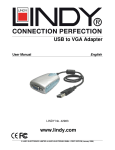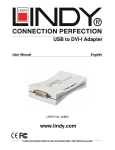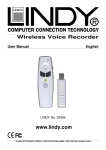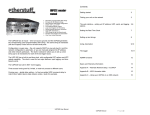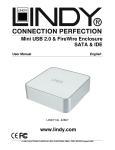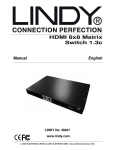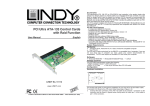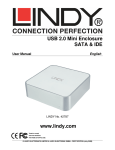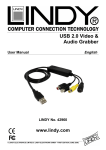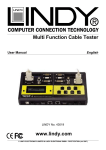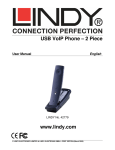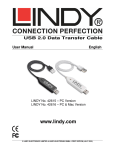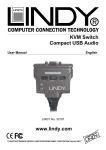Download Lindy 42339 KVM switch
Transcript
English User Manual Introduction The LINDY KVM Switch Lite HDMI USB is one of the latest generation of KVM switches that employs HDMI display technology for use with high definition digital monitors and flat screen TVs. It allows you to control two computers using only one USB keyboard and mouse and one HDMI or DVI-D equipped monitor. The switch can be used with both PCs and Macs and supports connection to a USB 2.0 hub which means you can connect and switch your peripherals too. Switching between computers is achieved using the supplied remote control, push button, keyboard hotkeys or with the supplied 'KVM Switcher' software. KVM Switch Lite HDMI & USB 2.0 English User Manual Package Contents LINDY KVM Switch Lite HDMI USB IR Remote Control LINDY HDMI Cable x 2 LINDY USB A/B Cable x 2 5V DC Multi-Country switching PSU CD-ROM Instruction manuals Features The LINDY KVM Switch Lite HDMI USB is a 2-port desktop USB KVM Switch that incorporates many advanced features: Supports HD-Ready digital flat panels, TVs and projectors with HDMI or DVI-D* connections Supports HDMI or DVI-D* output from PlayStation 3, X-Box as well as PC, Mac and other HDMI or DVI-D* equipped source devices. Supports HDMI 1.3 technology for digital video signal transmission of full HD 1080p and future HDMI 1.3 compliant colour depths as well as DVI-D* display resolutions up to 1920 x 1200. Supports USB keyboard, mouse and USB 2.0 device sharing when used with an additional USB 2.0 hub (not supplied). 4 way switching: IR remote control Push button on the switch Keyboard hotkey - user definable Using the supplied KVM switcher software (Windows and Mac) * When connecting the switch to DVI-D devices, an appropriate adapter (LINDY No. 41228) or HDMI to DVI-D cables are required. Visit the LINDY website for further details. LINDY No. 42339 www.lindy.com For Home and Office Use Tested to Comply with FCC Standards © LINDY ELECTRONICS LIMITED & LINDY-ELEKTRONIK GMBH - FIRST EDITION (JUNE 2008) Overscan and Computer video output to TV monitors via HDMI or DVI-D HD-Ready ports If you intend to connect a TV then make sure it is capable of supporting the resolution and refresh rates for your computer’s graphic cards. It may be necessary to adjust the display properties from within the options menu of your TV to turn off the “Overscan” function if your display appears incorrect, or cropped. Your TV’s options menu may refer to one of the following depending on make and model, look for Pixel to Pixel, True Pixel, Full Pixel, Non Scaled, Underscan, Overscan or similar. Overscan has been employed by televisions since their introduction. TVs are set to display a smaller area of the picture than what is received in order to ensure there will not be any black borders around the picture. This overscan is due to the TV settings and not the devices sending the signal to the TV. Only the most recent flat screen TVs allow this overscan to be turned off so check the user guide for your TV for more information. -2- English User Manual Installation English User Manual Switching Operation 1. Before connecting your new KVM Switch Lite, insert the CD-ROM into your computers CDROM drive. If the Autorun screen does not pop up automatically please start the program named Autorun.exe from the CD-ROM. 2. Click “Software Installation for Window/Mac” to start the installation. (If the Mac version software does not start, you should copy the files from the CD to your local Hard disk on the Mac and install from that location). 3. Once the installation has completed you will find a KVM Switcher icon on the system tray of your desktop. Right-click the icon to open the operation menu and double-click the icon to open the configuration box. Windows OS Mac OS There are four methods for controlling your KVM Switch for Computer channel selection: • • • • The supplied remote control The front panel button Hot-Key sequence (Scroll-Lock + Scroll Lock) KVM switcher software During the switching process the computer will enumerate each of the connected USB devices. This detection will introduce a small delay whilst the operating system detects the connected devices. The LED indicator on the front panel will blink during this process and will show a steady light when complete. Allow this process to complete before attempting to switch again. Front-panel button Computer channel is active on port 1 Computer channel is active on port 2 No live connection detected The KVM Switcher Software supports both Windows (98SE or later) and Mac OS 10.4 (Tiger or later) operating systems. For other OS platforms, such as Linux, you can still use the keyboard hotkey – Scroll Lock + Scroll Lock – to switch between computers. Please note hotkey switching is not available on Mac OS. 4. Connect the shared USB keyboard, mouse and monitor to the corresponding ports on the KVM Switch. If you want to connect more than 2 USB devices then simply connect an additional USB hub and power supply. 5. Connect each KVM PC port to a computer using the supplied cables. Connect the supplied power supply to the mains and to the KVM switch. After you have connected the KVM and computers properly, you can start using the KVM Switch immediately. The front-panel button gives you direct control over KVM switching operation. Simply press the button to switch to the corresponding port. It switches HDMI and USB signals. When the switching process has completed and USB drivers are loaded from the connected computer the switch button LED indicator is illuminated constantly. Universal Hotkey Sequence If you are using the KVM Switch in combination with computers running Windows or Linux OS you can use the universal hotkey sequence to switch between ports. This feature is not available to Mac OS users. Universal Hotkey sequence = Scroll Lock + Scroll Lock Each keystroke within a hotkey sequence should be pressed within 2 seconds. User Hotkey Sequence Using the supplied KVM Switcher software it is possible to define your own Hotkey to switch between computers. The default Hotkey sequences are: Hotkey sequence Computer 1 = Ctrl - Alt - 1 Hotkey sequence Computer 2 = Ctrl - Alt - 2 Some older computers with USB ports may require you to manually enable the USB (Legacy) support option in the BIOS settings before you can use any USB devices. If your USB interface does not work, please check the USB options in your computers BIOS. Please note that all 3 keys should be pressed and held together. Upon the release of all three keys the switching action will be executed. Information on how to configure the keys is provided in the KVM Switcher Software section of this guide. If you use Windows 98SE or Mac OS and have not yet installed a USB mouse on your computer, there might be an error message. It is suggested that you install your USB mouse on your computer before connecting it to the KVM Switch. Neither the universal hotkey, Scroll Lock + Scroll Lock or the user hotkey, Ctrl - Alt [command key], will allow you to switch to an empty port that is not connected with any computer. To force your KVM to switch to an empty port, just press the front-panel button to switch. Sharing High-speed USB Devices The two USB 2.0 ports on the front-panel are normally used for keyboard and mouse connections. However, they can also be used to connect any USB devices that you wish to share between the two connected computers, such as a printer or scanner etc. Please Note: If you share USB Storage devices please be aware that you will interrupt any active data transfer when switching to the other computer. Ensure all data transfers are completed before switching. -3- After switching ports, you have to wait until the KVM Switcher icon shows the target port before you can perform next switching action. The hotkey switching (universal/user) is only functional after your computers have booted into the OS. If you want to switch in the BIOS stage, press the front-panel button to switch. -4- English User Manual KVM Switcher Software The KVM Switcher Software allows more advanced functions as described in this section: Switching Right-click the KVM Switcher icon and select Switch to PC x Allthough the dialog box may show a selection for up to four PCs you can only select/switch to the PCs 1 or 2 on a 2 Port KVM Switch. Also you cannot switch to a port with no active computer connected (greyedout). Shielded cables must be used with this equipment to maintain compliance with radio frequency energy emission regulations and ensure a suitably high level of immunity to electromagnetic disturbances. FCC Warning Windows Mac OS WEEE (Waste of Electrical and Electronic Equipment), Recycling of Electronic Products Europe, United Kingdom User Hotkey You can now specify the command key as you like by typing it into the appropriate field. For example, you can specify the hotkey for switching to PC 1 as CTRL + ALT + “A” by typing an “A” (not case-sensitive) in the edit field. Windows This equipment has been tested and found to comply with the limits for a Class B digital device, pursuant to part 15 of the FCC Rules. These limits are designed to provide reasonable protection against harmful interference in a residential installation. This device complies with part 15 of the FCC Rules. Operation is subject to the following two conditions: 1. This device may not cause harmful interference, and 2. This device must accept any interference received, including interference that may cause undesired operation. Configuration Right-click the KVM Switcher icon and select Settings or double-click the icon to bring up the configuration dialog box. You can use any standard key on the keyboard as a hot key, with the exception of: Alt, Ctrl, Shift, Caps, Tab, Esc, Functions and Edit keys. All other keys on the keyboard, including those number keys on the number pad may be used. Radio Frequency Energy, Certifications Mac OS In 2006 the European Union introduced regulations (WEEE) for the collection and recycling of all waste electrical and electronic equipment. It is no longer allowed to simply throw away electrical and electronic equipment. Instead, these products must enter the recycling process. Each individual EU member state has implemented the WEEE regulations into national law in slightly different ways. Please follow your national law when you want to dispose of any electrical or electronic products. More details can be obtained from your national WEEE recycling agency. Germany Die Europäische Union hat mit der WEEE Direktive umfassende Regelungen für die Verschrottung und das Recycling von Elektro- und Elektronikprodukten geschaffen. Diese wurden von der Bundesregierung im Elektro- und Elektronikgerätegesetz – ElektroG in deutsches Recht umgesetzt. Dieses Gesetz verbietet vom 24.März 2006 an das Entsorgen von entsprechenden, auch alten, Elektro- und Elektronikgeräten über die Hausmülltonne! Diese Geräte müssen den lokalen Sammelsystemen bzw. örtlichen Sammelstellen zugeführt werden! Dort werden sie kostenlos entgegen genommen. Die Kosten für den weiteren Recyclingprozess übernimmt die Gesamtheit der Gerätehersteller. France En 2006, l'union Européenne a introduit la nouvelle réglementation (DEEE) pour le recyclage de tout équipement électrique et électronique. Chaque Etat membre de l’ Union Européenne a mis en application la nouvelle réglementation DEEE de manières légèrement différentes. Veuillez suivre le décret d’application correspondant à l’élimination des déchets électriques ou électroniques de votre pays. If you intend to modify the command key, you have to modify them on each of the connected computers, since the hotkey setting is stored within each connected computer. Italy Auto Scan Period Select the Auto-Scan period from 10 ~ 60 seconds with an increment of 5 seconds. The Auto-Scan period is the time your KVM Switch will wait before switching to the next computer. Once you have selected an Auto-Scan period you can then activate/deactivate this feature from the Operation Menu. Nel 2006 l’unione europea ha introdotto regolamentazioni (WEEE) per la raccolta e il riciclo di apparecchi elettrici ed elettronici. Non è più consentito semplicemente gettare queste apparecchiature, devono essere riciclate. Ogni stato membro dell’ EU ha tramutato le direttive WEEE in leggi statali in varie misure. Fare riferimento alle leggi del proprio Stato quando si dispone di un apparecchio elettrico o elettronico. Per ulteriori dettagli fare riferimento alla direttiva WEEE sul riciclaggio del proprio Stato. LINDY No 42339 1st Edition, June 2008 www.lindy.com -5- 6



